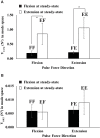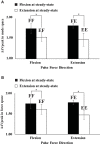Multi-Finger Interaction and Synergies in Finger Flexion and Extension Force Production
- PMID: 28674489
- PMCID: PMC5474495
- DOI: 10.3389/fnhum.2017.00318
Multi-Finger Interaction and Synergies in Finger Flexion and Extension Force Production
Abstract
The aim of this study was to discover finger interaction indices during single-finger ramp tasks and multi-finger coordination during a steady state force production in two directions, flexion, and extension. Furthermore, the indices of anticipatory adjustment of elemental variables (i.e., finger forces) prior to a quick pulse force production were quantified. It is currently unknown whether the organization and anticipatory modulation of stability properties are affected by force directions and strengths of in multi-finger actions. We expected to observe a smaller finger independency and larger indices of multi-finger coordination during extension than during flexion due to both neural and peripheral differences between the finger flexion and extension actions. We also examined the indices of the anticipatory adjustment between different force direction conditions. The anticipatory adjustment could be a neural process, which may be affected by the properties of the muscles and by the direction of the motions. The maximal voluntary contraction (MVC) force was larger for flexion than for extension, which confirmed the fact that the strength of finger flexor muscles (e.g., flexor digitorum profundus) was larger than that of finger extensor (e.g., extensor digitorum). The analysis within the uncontrolled manifold (UCM) hypothesis was used to quantify the motor synergy of elemental variables by decomposing two sources of variances across repetitive trials, which identifies the variances in the uncontrolled manifold (VUCM) and that are orthogonal to the UCM (VORT). The presence of motor synergy and its strength were quantified by the relative amount of VUCM and VORT. The strength of motor synergies at the steady state was larger in the extension condition, which suggests that the stability property (i.e., multi-finger synergies) may be a direction specific quantity. However, the results for the existence of anticipatory adjustment; however, no difference between the directional conditions suggests that feed-forward synergy adjustment (changes in the stability property) may be at least independent of the magnitude of the task-specific apparent performance variables and its direction (e.g., flexion and extension forces).
Keywords: anticipatory synergy adjustment; finger extension; finger flexion; multi-finger synergy; uncontrolled manifold hypothesis.
Figures







Similar articles
-
Effects of spastic cerebral palsy on multi-finger coordination during isometric force production tasks.Exp Brain Res. 2019 Dec;237(12):3281-3295. doi: 10.1007/s00221-019-05671-3. Epub 2019 Oct 29. Exp Brain Res. 2019. PMID: 31664488
-
Multi-finger synergies and the muscular apparatus of the hand.Exp Brain Res. 2018 May;236(5):1383-1393. doi: 10.1007/s00221-018-5231-5. Epub 2018 Mar 12. Exp Brain Res. 2018. PMID: 29532100 Free PMC article.
-
Two sources of performance-stabilizing synergies: An experimental exploration using finger force production.Hum Mov Sci. 2025 Jun;101:103369. doi: 10.1016/j.humov.2025.103369. Epub 2025 May 31. Hum Mov Sci. 2025. PMID: 40451038
-
Coordination in adults with neurological impairment - A systematic review of uncontrolled manifold studies.Gait Posture. 2019 Mar;69:66-78. doi: 10.1016/j.gaitpost.2019.01.003. Epub 2019 Jan 2. Gait Posture. 2019. PMID: 30677709
-
Neural control of movement stability: Lessons from studies of neurological patients.Neuroscience. 2015 Aug 20;301:39-48. doi: 10.1016/j.neuroscience.2015.05.075. Epub 2015 Jun 3. Neuroscience. 2015. PMID: 26047732 Free PMC article. Review.
Cited by
-
Bio-Inspired Control System for Fingers Actuated by Multiple SMA Actuators.Biomimetics (Basel). 2022 May 13;7(2):62. doi: 10.3390/biomimetics7020062. Biomimetics (Basel). 2022. PMID: 35645189 Free PMC article.
-
Frequency-Dependent Effects on Coordination and Prefrontal Hemodynamics During Finger Force Production Tasks.Front Hum Neurosci. 2021 Oct 18;15:721679. doi: 10.3389/fnhum.2021.721679. eCollection 2021. Front Hum Neurosci. 2021. PMID: 34733144 Free PMC article.
-
Effects of spastic cerebral palsy on multi-finger coordination during isometric force production tasks.Exp Brain Res. 2019 Dec;237(12):3281-3295. doi: 10.1007/s00221-019-05671-3. Epub 2019 Oct 29. Exp Brain Res. 2019. PMID: 31664488
-
Expectation of movement generates contrasting changes in multifinger synergies in young and older adults.Exp Brain Res. 2018 Oct;236(10):2765-2780. doi: 10.1007/s00221-018-5333-0. Epub 2018 Jul 18. Exp Brain Res. 2018. PMID: 30022260
-
Age Effects in Postural Control Analyzed via a Principal Component Analysis of Kinematic Data and Interpreted in Relation to Predictions of the Optimal Feedback Control Theory.Front Aging Neurosci. 2018 Feb 5;10:22. doi: 10.3389/fnagi.2018.00022. eCollection 2018. Front Aging Neurosci. 2018. PMID: 29459826 Free PMC article.
References
-
- Bernstein N. A. (1967). The Co-Ordination and Regulation of Movements. Oxford: Pergamon Press.
LinkOut - more resources
Full Text Sources
Other Literature Sources

